![]()
Aurora Photography
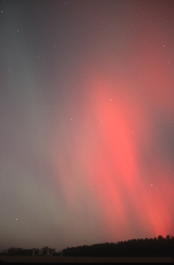
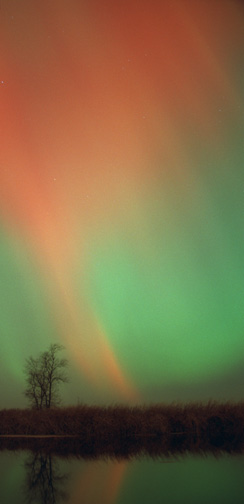
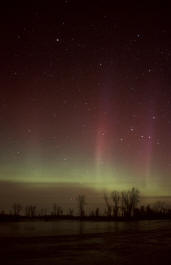
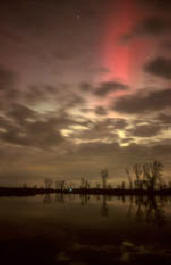
2001 Auroras, Early 2002_Auroras,
"Aurora Borealis", the Latin name of the aurora of the northern hemisphere, means "northern dawn"...
This tutorial will help you view and capture the elusive "Northern Lights".
Now is the best time to try. Our sun is still near solar max. That means that it is at its peak in solar activity. This peak happens every 10-11 years or so.
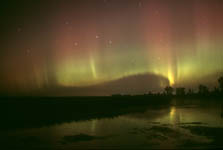
Are they in your area?
How can you see auroras? Check these plots to see if anything is happening. If the velocity and Bz are in the red/orange, there is a chance of visible activity. Though there are no guarantees. Also, check the Aurora Forum. There will most likely be lots of activity on there if something is coming. Spaceweather.com is another good source, though they can be a bit optimistic at times.
Another source that shows maps of the northern hemisphere with the current activity level can be found here.
Then look here. Click where you are located. Make note of your corrected magnetic latitude. The farther North you live, the better.
If there is activity, then look here and make note of the intensity of the last (Kp) bar. Remember, this bar covers a three hour period. Activity could currently be high or it peaked and is on it's way down. So get out if it is good and clear!
Now here is a table from the Space Environmental Center:
|
Mag. Lat |
intensity |
| 60.4 | 3 |
| 58.3 | 4 |
| 56.3 | 5 |
| 54.2 | 6 |
| 52.2 | 7 |
| 50.1 | 8 |
| 48.1 | 9 |
Now if you are at 54 degrees like me, you will only have the opportunity to see auroras when the intensity is at 6 or above. From experience though, I have seen them barely glowing when activity has only gotten up to 4 or 5. It just depends...
By far the best source for aurora monitoring is probably the Space Weather Information Monitor (SWIM). There is a wealth of information just a mouse click away with this fine program.
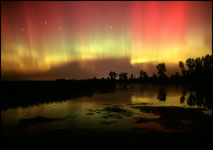
Equipment
Camera Support
You will absolutely NEED a tripod. The exposures, depending on the speed of your lens, will be greater than 10 seconds.
Camera
Any camera will do... As long as it has a provision for multi-second, BULB or TIME exposures. It will also need to be able to take a cable release as you can't hold the shutter button with your finger. Triggering the shutter with your finger could also cause vibration. You will risk unsharpness if you forget the release.
Digital cameras work well if you can leave the shutter open long enough.
Lenses
Wide angle lenses are preferred. Auroras usually cover a large portion of the sky. The larger the aperture the better. Using a larger aperture lets you use shorter exposure times and thus capturing more detail in the auroral structure. Something in the 1.4-3.5 range will do. My wide angle lenses are a 28 f/1.8 for 35mm and a 35mm f/3.5 in 6x4.5cm. You will use them wide open most likely.
Set your lens to infinity focus. Auroras will be hundreds if not thousands of miles away.
Film
Usually ISO 400 or higher is preferred. The two films that I have used are Fuji Provia 400F and Fuji NPH 400. They both give me great results. Though I prefer Provia 400F. Other common films are Fuji Superia 800, Kodak 800 and 1000. Film grain then becomes a concern.
Time
Lots of PATIENCE.
You will be sitting out for long periods of time. Either waiting for auroras to appear or waiting for each of your long exposures to finish. Sometimes you will be disappointed. The few times where the sky bursts forth will make you forget all of the waiting.
Wear warm clothes too. Fall or Winter are when auroral activity is usually greatest, the temperatures will fall and it's not very warm sitting out at 1AM anyway. A folding camp chair could be useful.
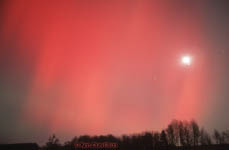
Exposure
Time exposures for auroras depend on three things: Lens maximum aperture, film speed, and the intensity of the aurora.
My fastest 35mm format wide angle is a 28mm f/1.8. I then use 400 speed film (Fuji Provia 400F). With that combo, 15-20 seconds works well. I have a 50mm f/1.8 and I would then also expose for about 15-20 seconds. Before I had those fast lenses, my 28-135 was my fastest at f/3.5. Exposure times with that lens looked best at 60-90 seconds. Never could catch much form with that long of an exposure. I couldn't shoot as much film either.
If the aurora is weak I may extend the exposure time a bit or not shoot it <-not likely. Strong auroras take the 15-20 seconds well at f/1.8 although I may take a few at shorter exposures just to see. The Canon TC-80N3 Remote Cord will come in handy shooting auroras if you have the appropriate EOS camera (3, 1v, 1ds, 1d, D30, D60, 10D, D2000).
With my Pentax 645NII medium format camera, my fastest lenses are all f/2.8's (45mm, 55mm, 75mm and 150mm) except for the zoom. With Provia 400F, I have found that 40-45 seconds gives me good results at f/2.8. For the Pentax, they make a timer remote called the TS-110 for which I can program time exposures. It does many of the same functions as the Canon TC-80N3.
Here is a table with the exposure time in seconds for each aperture and ISO value:
| Aperture ISO |
1.8
|
2
|
2.8
|
3.5/4
|
| 400 | 15-20 | 24-30 | 45-60 | 120 |
| 800 | 8-10 | 12-15 | 22-30 | 60 |
Composition
Auroras around here (Wisconsin) usually don't get very high in the sky. I try to find a body of water to reflect some of the auroras. Sometimes when the moon is bright, it will illuminate the foreground very nicely. If it is a strong display, vertical compositions work if you have a strong foreground or a good reflection.
Clear Skies
Lastly, you need clear skies. Duh!
Get away from any city. Light pollution is the worst enemy of auroras (or any astronomical event for that matter). Get at least 10-20 miles away and bring a map (to get back :-) and a chair. The moon can spoil viewing too.
You can't predict the weather. Many times when there is strong activity it is either cloudy or raining. Sigh...
Here is a map of cloud cover for the US. Useful for checking cloud cover at night when visible radar becomes useless.
Good Luck!!!
![]()